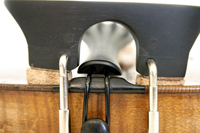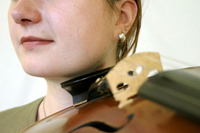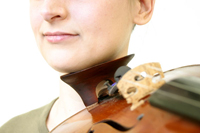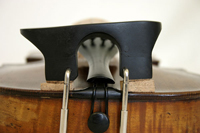Chin Rest: Adjustable in all directions
3. Tilt

Tilt was also adjusted to allow for a healthy balance of the head on the spine. We could adjust the tilt of the chin rest with the large collection of slanted corks in our Chin Rest Testing Kit. The most common tilt was down to the left (slanting down from the e-string to the g-string side) since this allowed the strings to be angled towards the bow.
Tilt: slanting down to the right
Tilt is important for two reasons:
1. To match the jaw shape
The tilt of the chin rest should match the angle of the jaw of the player. People with a pointed, sharp jaw shape need the chin rest to be tilted more to the right (towards the e-string) than those with a square jaw. To match the jaw shape, the shape of the chin rest cup also has to be adjusted. (see below).


Different jaw shapes require different tilt and cup shape.
2. To tilt the strings towards the bow

When adjusting the tilt, you should also take into account the angle of the instrument in relation to the bow and to the fingering hand. A well-adjusted tilt means that the player can bow and finger with ease on all strings while the head stays well balanced on the spine. Tall players can usually reach all the strings easily with the bow, but smaller players may need to have the instrument tilted more to the right, towards the bow, in order to play easily on the lowest string. To tilt the instrument to the right, you need to tilt the chin rest to the left. Smaller players therefore need more tilt to the left in the chin rest (towards the g-string).
Tilt: slanting down to the left
